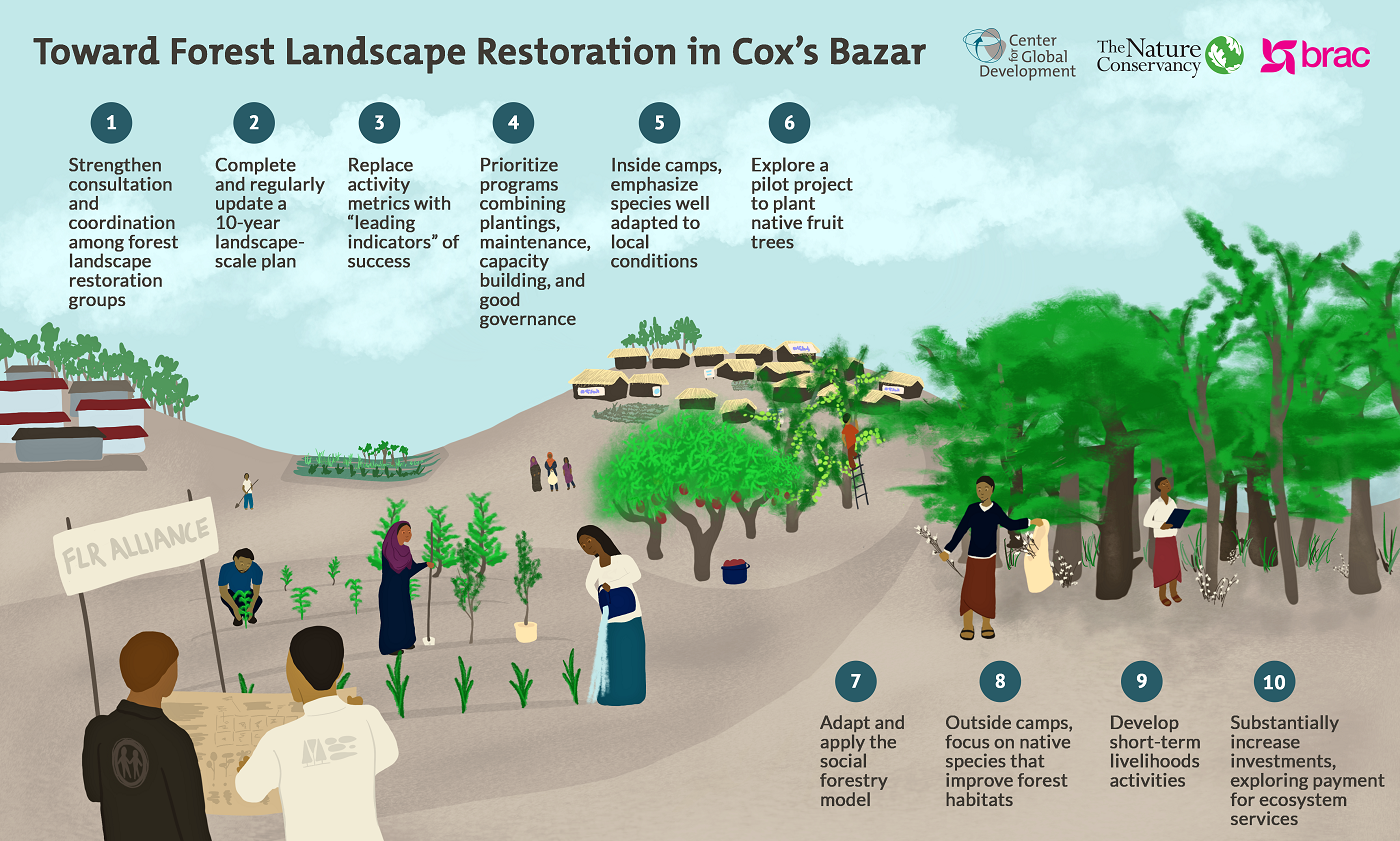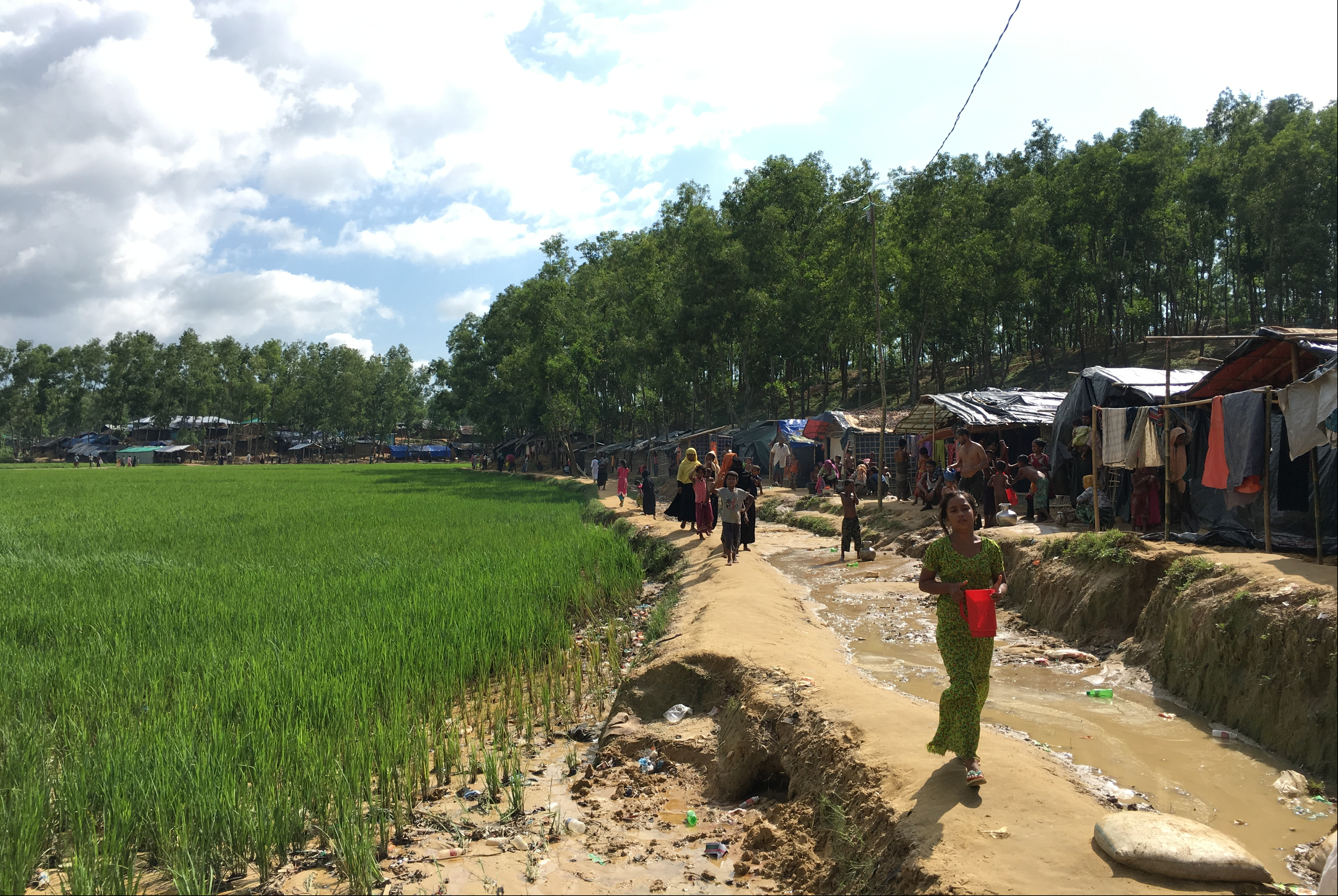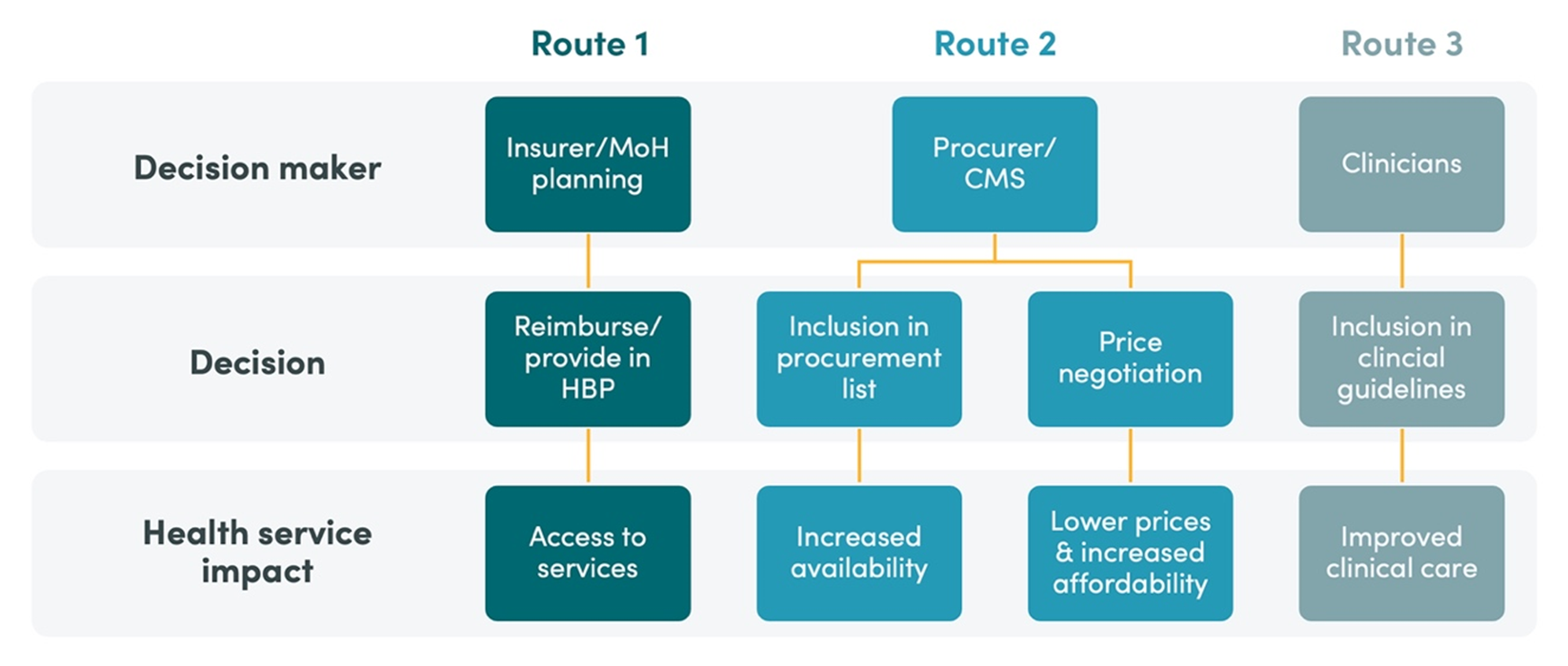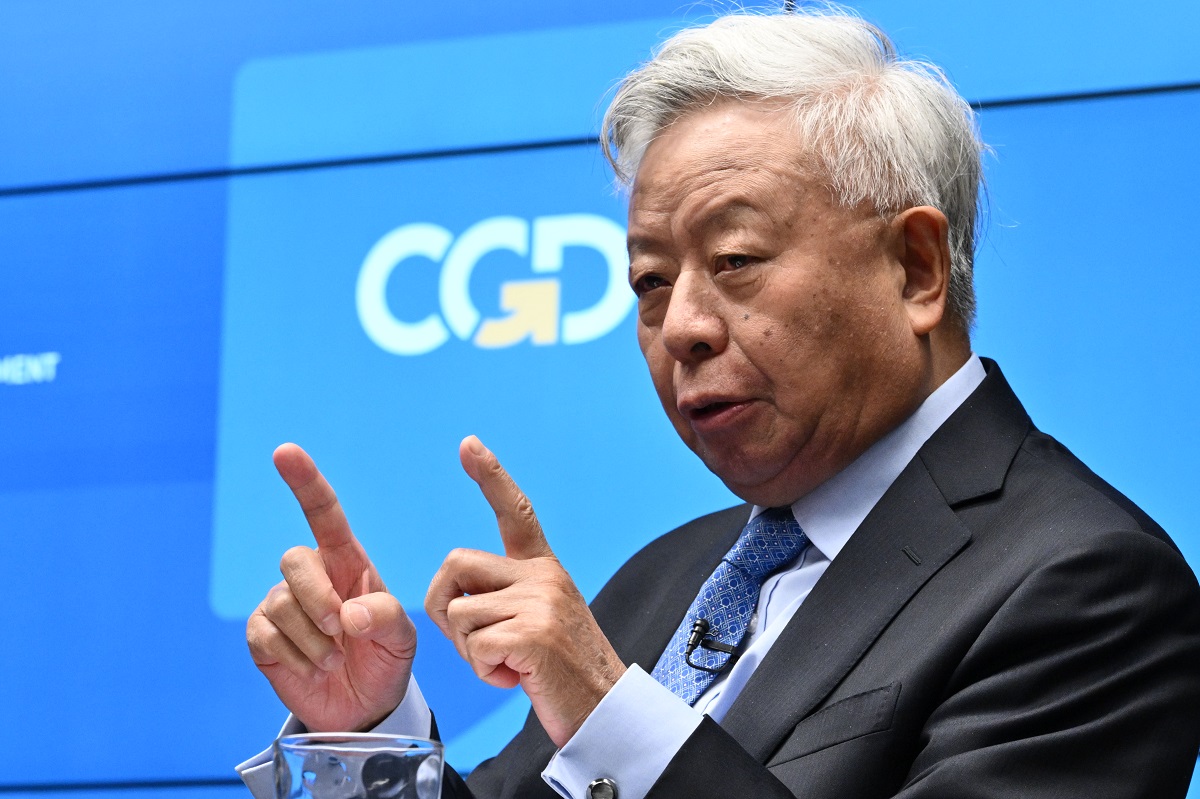Recommended
Rohingya refugees began arriving in Bangladesh in August 2017, fleeing atrocities deemed serious crimes under international law by United Nations investigators. Over 740,000 new refugees have settled in two camps in Cox’s Bazar district of Chittagong: Kutupalong-Bulukhali and Naypara-Leda. The number of Rohingya in Cox’s Bazar now stands at around one million, comprising about 30 percent of the population. Kutupalong-Bulukhali is now the largest refugee camp in the world. The influx of Rohingya into Cox’s Bazar has exacerbated deforestation, underdevelopment, and climate vulnerability. Combined, these factors create an urgent need for new strategies and resources to address the increasing stress placed on the environment, and the consequences of this stress for refugee and host communities.
Significant environmental and climate challenges in Cox’s Bazar associated with the influx of refugees include diminished livelihoods for local populations due to deforestation and loss of access to land; soil and slope erosion; fuelwood scarcity and associated safety risks for people collecting fuelwood; reduced foraging area and movement pathways for elephants, resulting in human-wildlife conflict; increased encroachment and forest degradation; declining water quality, groundwater reserve depletion and air pollution; decreasing soil quality; and climate vulnerability, including along the coastline. While these trends existed before the 2017 refugee influx, they have been greatly accelerated and exacerbated by it. UN agencies and the government of Bangladesh (GOB) are providing liquefied petroleum gas (LPG) for refugees and hosts, but harvest pressure will only be reduced if these efforts are further scaled-up and donors make strategic investments to identify sustainable solutions, preferably from non-fossil sources.
To contribute to a growing base of knowledge and expertise on opportunities to reverse the specific effects of forest loss and degradation—and to improve the conditions of host populations and refugees in Cox’s Bazar—BRAC, the Center for Global Development, and The Nature Conservancy convened workshops with global and national experts and stakeholders in September 2018 in Cox’s Bazar. The research also included field visits to Kutupalong-Bulukhali camp. Based on desk research, consultations, and these workshops, we developed recommendations to help drive progress for the Rohingya and host communities, and align environmental, humanitarian, and development objectives.
We present 10 core recommendations for forest and landscape restoration (FLR) in Cox’s Bazar to help restore cleared forest areas and improve human and environmental well-being:
To Improve Efficiency and Scale Impact of Reforestation Investments:
-
Strengthen consultation and coordination among groups involved in FLR through the Energy and Environment Technical Working Group (EETWG) and consider creating a standing alliance for FLR as efforts scale. All groups conducting, or planning to conduct, FLR and related activities should be engaged through existing coordination mechanisms, ensuring that Rohingya refugee and host communities are represented in a meaningful and gender-balanced way. In the future, it may be useful to create a standing alliance focused on FLR.
-
Complete and regularly update a 10-year landscape-scale plan for FLR that aligns efforts across sectors. Measurable and sustainable restoration progress will require the creation of a multiyear FLR plan, building on the Joint Response Plan, that aligns efforts on fuel and energy, nutrition, security (e.g., elephant-human conflict and safety during informal timber and firewood collection), water management, shelter construction and maintenance, and infrastructure development. It should also include an integrated spatial plan for FLR in and outside camps across Cox’s Bazar. FLR plans should be adapted based on the timing and scale of refugee repatriation; however, under all scenarios, FLR planning must be longer-term to yield sustainable results.
To Improve Seedling Survival and Benefits Inside and Outside Camps:
-
Set clear goals and objectives, and replace activity metrics (such as area planted, number of seedlings planted or distributed, number of projects) with “leading indicators” of success (such as percent or number of seedlings surviving, seedling growth, soil erosion, or percent of population engaged in maintenance activities).[1] Goals will differ inside and outside camps and should be specified. The goals selected should be paired with measurable, time-bound performance criteria that can guide the level and nature of investment needed and improve program design. Programs focused on activities (plantings, seedling distribution) alone will fail, and use of leading indicators can significantly improve program success. Indicators should be mirrored in the Joint Response Plan and across all implementors.
-
Build capacity of local communities and ensure seedling survival by prioritizing programs that combine plantings, maintenance, capacity building, and good governance arrangements. Program adjustments should include a co-development process with individuals or groups who will conduct maintenance and build relevant capacities. Co-development processes should consider agreements on who manages trees; what incentives are received (e.g., vegetable plots, cash payments); who receives which benefits (e.g., vegetable or fruit harvest, fuel wood, shade); and how the program is managed (e.g., who keeps records, monitors activities, measures success). This recommendation is especially important for actors focused on social cohesion efforts, including the World Bank.
To Improve Disaster Resilience and Nutrition Inside Camps:
-
Diversify species mix to emphasize fast-growing native species well adapted to local conditions. We recommend drawing from EETWG technical guidelines and consulting further with local forestry and wildlife life experts to select a diversity of native species that are adapted to different soil and microclimatic conditions.[2] Planting a diversity of species will help to meet multiple objectives and provide greater resilience, since monocultures of trees are more susceptible to pest outbreaks. We strongly encourage the use of native species for plantings in and around camps when they are compatible with project objectives, since native species are generally better adapted to local conditions and may have a higher rate of establishment success, especially through cyclone conditions.
-
Explore a pilot project to plant native fruit trees that provide nutrition. Planting fruit trees in the camp may be an effective way to meet multiple objectives, including improved nutrition for Rohingya and bank stabilization. Some promising species to test include jackfruit (Artocarpus heterophyllus), Dhaki jam (Syzygium sp.), Amloki (Phyllanthis emblica), Guajava (Psidium guajava), mango (Mangifera indica), Dewa (Artocarpus lacucha), and coconut (Cocos nucifera). Local authorities could explore options that allow flexibility in the current policy prohibiting homestead fruit species inside the camps in order to support nutrition requirements for refugees without enabling encroachment. If a policy shift does not occur, planting more currently permitted fruit trees should be prioritized. This recommendation should be implemented in close consultation with the nutrition cluster.
To Increase Ecological and Social Benefits Outside of Camps:
-
Adapt and apply the widely used social forestry model to generate greater livelihoods and environmental benefits. Valuable lessons can be learned from the various social forestry programs implemented to date in Bangladesh and elsewhere that can be applied and tailored to local conditions to provide livelihoods and incentives for sustained, improved FLR, and forest management.
-
Diversify species mix and improve local nurseries to emphasize native species (such as native Dipterocarp species) that support forest habitat and local livelihoods. Consult with local restoration and wildlife experts to develop reforestation systems that incorporate a mix of fast-growing species ideal for site capture and stabilization,[3] along with slower-growing native canopy species that can set the trajectory for future forest recovery. Supporting the implementation of basic guidelines, such as seedling quality evaluations, and improving the quality of set-up for the nursery can quickly yield improvements that will support near- and longer-term FLR objectives.
-
Develop short-term livelihoods activities that can improve environmental outcomes. Near-term needs for fuelwood and native seedling supplies could be addressed through new livelihood programs with host communities (and Rohingya, if cash-for-work policies shift). Under close supervision of the Bangladesh Forest Department, this two-part program would (1) support nursery business development, and (2) provide incentives to selectively remove woody invasive species and replant native seedlings in buffer areas around the Teknaf Wildlife Sanctuary, Himchari National Park, and Inani National Park. Harvested invasive woody weeds could be used for fuelwood, and replanted native species would contribute to reforestation and possible social forestry initiatives. The proposal would be designed so it is consistent with the current Bangladesh Forest Department policies. This recommendation is especially important for agencies and NGOs that are prioritizing livelihood efforts and women’s empowerment.
-
Substantially increase the scale of FLR investments to realize potential benefits for carbon and economic development in Cox’s Bazar, including by exploring payment for ecosystem services. Bangladesh’s REDD+ readiness and the current plans for FLR need to improve and expand to realize potential carbon benefits and livelihood contributions for Cox’s Bazar. Multiple financing mechanisms beyond humanitarian aid could catalyze the necessary scale of effort.
Bangladesh provides a significant global public good by hosting nearly one million Rohingya refugees. Most are living in camps in Cox’s Bazar District, where resources and livelihoods are strained. The refugee situation is likely to be protracted, and medium-term planning is critical. CGD has been working with local and international partners to understand what that medium-term response could look like. This brief is one of five (covering forest and landscape restoration, trade, private sector investment, labor mobility, and policy priorities) where we outline steps for developing a medium-term plan for Bangladesh, to benefit refugees and their host community alike. The full paper on which this brief is based is available at /publication/steps-toward-forest-landscape-restoration
[1] We understand that these indicators are included in the EETWG’s 2019 plans. The next step should be full adoption of these indicators by all groups involved in plantings, and transparency of any indicators and plans to ensure accountability.
[2] Three species lists were approved by the Bangladesh Forest Department for 2019 planting. The lists follow this recommendation and include only native species. Use of lists now needs to be enforced.
[3] The EETWG has made efforts to incorporate a mix of fast-growing species for site capture and stabilization. 2019 plans include a more sophisticated system for promoting collaborative efforts of mixed vegetation and local species strategies.
Rights & Permissions
You may use and disseminate CGD’s publications under these conditions.








